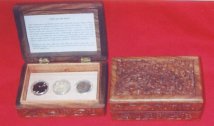


Frankincense was one of the most prized and costly substances in the ancient world, worth more than its weight in gold. Thanks to the domestication of the camel, a complex trade network evolved to transport the priceless resins from the remote valleys, where the trees grew, to the markets where kings and emperors vied for the finest grades.
The ceremonial incense of the Jews was compounded of four 'sweet scents,' of which pure Frankincense was one, pounded together in equal proportion. It is frequently mentioned in the Pentateuch. Pure Frankincense formed part of the meet offering and was also presented with the shew-bread every Sabbath day. With other spices, it was stored in a great chamber of the
House of God at Jerusalem.
According to Herodotus, Frankincense to the amount of 1,000 talents weight was offered every year, during the feast of Bel, on the great altar of his temple in Babylon. The religious use of incense was as common in ancient Persia as in Babylon and Assyria. Herodotus states that the Arabs brought every year to Darius as tribute 1,000 talents of Frankincense, and the modern Parsis of Western India still preserve the ritual of incense.
The kohl, or black powder with which the Egyptian women paint their eyelids, is made of charred Frankincense, or other odoriferous resin mixed with Frankincense. Frankincense is also melted to make a depilatory, and it is made into a paste with other ingredients to perfume the hands. A similar practice is described by Herodotus as having been practised by the women of Scythia and is alluded to in Judith x. 3 and 4. In cold weather, the Egyptians warm their rooms with a brazier whereon incense is burnt, Frankincense, Benzoin and Aloe wood being chiefly used for the purpose.
Today frankincense is mainly used in incenses and pastilles although the essential oils are often used in aromatherapy. Frankincense is still used today to treat a number of conditions including ulcers, bronchitis, snakebites and jaundice.
The ceremonial incense of the Jews was compounded of four 'sweet scents,' of which pure Frankincense was one, pounded together in equal proportion. It is frequently mentioned in the Pentateuch. Pure Frankincense formed part of the meet offering and was also presented with the shew-bread every Sabbath day. With other spices, it was stored in a great chamber of the
House of God at Jerusalem.
According to Herodotus, Frankincense to the amount of 1,000 talents weight was offered every year, during the feast of Bel, on the great altar of his temple in Babylon. The religious use of incense was as common in ancient Persia as in Babylon and Assyria. Herodotus states that the Arabs brought every year to Darius as tribute 1,000 talents of Frankincense, and the modern Parsis of Western India still preserve the ritual of incense.
The kohl, or black powder with which the Egyptian women paint their eyelids, is made of charred Frankincense, or other odoriferous resin mixed with Frankincense. Frankincense is also melted to make a depilatory, and it is made into a paste with other ingredients to perfume the hands. A similar practice is described by Herodotus as having been practised by the women of Scythia and is alluded to in Judith x. 3 and 4. In cold weather, the Egyptians warm their rooms with a brazier whereon incense is burnt, Frankincense, Benzoin and Aloe wood being chiefly used for the purpose.
Today frankincense is mainly used in incenses and pastilles although the essential oils are often used in aromatherapy. Frankincense is still used today to treat a number of conditions including ulcers, bronchitis, snakebites and jaundice.

